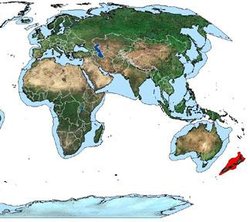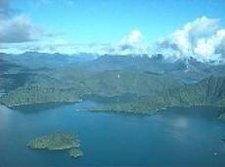New Zealand Shelf (LME)
Contents
- 1 New Zealand Shelf large marine ecosystem
- 1.1 IntroductionThe New Zealand Shelf Large Marine Ecosystem (LME) is characterized by its temperate climate. It stretches across 30 degrees of latitude from the subtropics in the North down to the sub-Antarctic region. The shelf surrounding New Zealand’s two main islands varies in width from 150 kilometers (New Zealand Shelf large marine ecosystem) (km) to 3,000 km. The LME is influenced by the warm South Equatorial Current in the north, and by the cooler West Wind Drift in the South. The marine environment is very diverse and includes estuaries, mudflats, mangroves, seagrass and kelp beds, reefs, seamount communities and deep sea trenches.
- 1.2 Productivity
- 1.3 Fish and Fisheries
- 1.4 Pollution and Ecosystem Health
- 1.5 Socioeconomic Conditions
- 1.6 Governance
- 1.7 References
- 1.7.1 Articles and LME Volumes FAO, 2003. Trends in oceanic captures and clustering of large marine ecosystems—2 studies based on the FAO capture database. FAO fisheries technical paper 435. 71 pages.Morgan, J., 1989. Large Marine Ecosystems in the Pacific Ocean. In: Biomass Yields and Geography of Large Marine Ecosystems, K. Sherman and L.M. Alexander, eds. AAAS Selected Symposium, 377-394. ISBN: 0813378443 (New Zealand Shelf large marine ecosystem) .
- 1.7.2 Other References
- 1.7.3 Citation
New Zealand Shelf large marine ecosystem
IntroductionThe New Zealand Shelf Large Marine Ecosystem (LME) is characterized by its temperate climate. It stretches across 30 degrees of latitude from the subtropics in the North down to the sub-Antarctic region. The shelf surrounding New Zealand’s two main islands varies in width from 150 kilometers (New Zealand Shelf large marine ecosystem) (km) to 3,000 km. The LME is influenced by the warm South Equatorial Current in the north, and by the cooler West Wind Drift in the South. The marine environment is very diverse and includes estuaries, mudflats, mangroves, seagrass and kelp beds, reefs, seamount communities and deep sea trenches.
Productivity
 Location of the New Zealand Shelf Large Marine Ecosystem. (Source: NOAA)
Location of the New Zealand Shelf Large Marine Ecosystem. (Source: NOAA) The New Zealand Shelf Large Marine Ecosystem is considered a Class II, moderately high (150-300 gC/m2-yr) productivity ecosystem based on SeaWiFS global primary productivity estimates. For a study of ocean fronts and their contribution to marine productivity in this LME, see the NIWA website. See research work of the National Institute of Water]and Atmospheric Research (NIWA). Estimated marine species to be found in the New Zealand Shelf LME approach 23,000 but fewer than 12,000 have been identified. Known species include 612 seabirds, 41 marine mammals, 964 fish, 2,000 mollusks and 700 different seaweeds. SeaWiFS has an image of ocean chlorophyll in New Zealand coastal waters. In the Southern part of the LME, there is higher productivity in the fiord marine ecosystems, but they are in need of protection.
Fish and Fisheries
 New Zealand Shelf Large Marine Ecosystem. (Source: NOAA)
New Zealand Shelf Large Marine Ecosystem. (Source: NOAA) The Food and Agriculture Organization (FAO) 10-year trend shows a decrease of the total catch, from 290,000 tons in 1990 to 250,000 tons in 1999 (see FAO, 2003). The graph (see FAO, 2003, Figure 22) indicates a succession of peaks and troughs, with a high average percentage of pelagic fishes (33%), demersal fishes (26%), and cods, hakes and haddocks (10%). Among the important fisheries of the area are those for migratory apex predators such as tuna, billfish, and sharks. There is also a bottom fishery for the orange roughy, and a coastal fishery for a variety of crustaceans and mollusks. The fishing industry is mostly export-oriented. In recent years the value of fish exports ($1.2 billion in 1993) has grown much more than the volume of fish exports. The current commercial fishing rights regime does not ensure the sustainable management of fisheries and other marine resources. The current allowable daily take of various marine organisms is set too high for sustainability. Fisheries policy in New Zealand, however, supports a long-term future for the industry which would be achieved by setting sustainable catch limits and providing secure harvesting rights. This should provide a framework that allows the fishing industry to be both competitive and sustainable. The government must conserve and manage fisheries for the benefit of all New Zealanders, including the indigenous Maori. The fiords support commercial and recreational fisheries as well as traditional Maori fisheries. See the FAO website for fisheries within the New Zealand Shelf LME . Fisheries information is also available from the New Zealand Ministry of Fisheries. For information on closed areas, see the New Zealand Department of Conservation. For detailed information on fisheries in this LME, see data collected by the University of British Columbia Fisheries Center. See the graph below for a view of the data.
Pollution and Ecosystem Health
Fisheries (Fisheries and aquaculture) impacts on the environment are not completely understood and the data is incomplete. Gill nets pose a risk to marine birds, particularly if set near feeding or breeding areas. Yellow-eyed penguins appear most at risk from nets set by commercial fishermen for bottom dwelling species such as rig and dogfish. The nets are set well within the feeding range of these penguins. Fiord [[ecosystem]s] in the South of this LME are in need of protection. In that region, the crested penguin Eudyptes pachyrhynchus is at risk. Native flora and fauna are affected the invasions of the Asian kelp Undaria and toxic micro-algae. For more information on marine invasions, ballast water, marine toxins, harmful algal blooms and diarrhetic shellfish poisoning, see Cawthron research programs. It has been suggested that changes in sea surface conditions have contributed to the spread of toxic algae and invasive seaweeds in New Zealand waters. Toxic algal blooms occurring in the 1990s have killed marine life and caused illness in humans. Other issues affecting the marine environment are waste and hazardous substances. New Zealand produces a higher rate of municipal waste (two thirds of a ton per person each year) than most other developed countries. Industrial waste is estimated at 300,000 tons a year. Another ecosystem health issue is climate change. Gases released into the atmosphere are enhancing the natural greenhouse effect at a rate that could extensively damage the LME’s biophysical systems. Atmospheric levels of carbon dioxide and methane–two of New Zealand's major greenhouse gases–are rising.
Socioeconomic Conditions
 New Zealand Shelf Large Marine Ecosystem. (Source: NOAA)
New Zealand Shelf Large Marine Ecosystem. (Source: NOAA) While sustaining a great variety of plant and animal life, the marine environment is subject to the effects of human activity. Commercial, recreational and indigenous fishermen (Maoris and Pacific Islanders) and marine aquaculturalists use the living resources of this LME. It is also used for recreation, trade, defense and security. The ocean floor is explored and mined for minerals, natural gas and oil. Ports and harbors in this LME are Auckland, Christchurch, Dunedin, Tauranga, and Wellington. Statistics New Zealand has developed socioeconomic indicators for the environment that complement the Ministry for the Environment's Environmental Performance Indicators (EPI) program.
Governance
The New Zealand Shelf Large Marine Ecosystem is governed by New Zealand. In the area of fisheries, issues arising from the conflict between commercial and conservation interests is addressed under different regulations administered by the Southland Regional Council, the Department of Conservation, and the Ministry of Fisheries. Managing the marine environment is a complex process involving overlapping and conflicting interests, agencies and legislation. There is a lack of communication among stakeholders of the marine environment that inhibits the advancement of sustainable management. New Zealand’s Department of Conservation is responsible for marine reserves and for marine mammals such as dolphins, whales, sea lions and fur seals. New Zealand has a number of coastal national parks (Bay of Islands Maritime and Historic Park, Hauraki Gulf Maritime Park). More information on marine reserves is available at the New Zealand Department of Conservation. There is a need for more marine science. The issue of climate change needs to be addressed. New Zealand is party to the following treaties: Antarctic-Environmental Protocol, Antarctic-Marine Living Resources, Antarctic Treaty, Biodiversity, Climate Change, Desertification, Endangered Species, Environmental Modification, Hazardous Wastes, Law of the Sea, Marine Dumping, Nuclear Test Ban, Ozone Layer Protection, Ship Pollution, Tropical Timber 83, Tropical Timber 94, Wetlands, and Whaling.
References
Articles and LME Volumes FAO, 2003. Trends in oceanic captures and clustering of large marine ecosystems—2 studies based on the FAO capture database. FAO fisheries technical paper 435. 71 pages.Morgan, J., 1989. Large Marine Ecosystems in the Pacific Ocean. In: Biomass Yields and Geography of Large Marine Ecosystems, K. Sherman and L.M. Alexander, eds. AAAS Selected Symposium, 377-394. ISBN: 0813378443 (New Zealand Shelf large marine ecosystem) .
Other References
- Atlas of the living resources of the sea. 1972. Department of Fisheries, Food and Agriculture Organization of the United Nations (FAO), Rome. ISBN: 9250010001.
- Boyd, P.W.; LaRoche, J.; Gall, M.; Frew, R.; McKay, R., 1999. Role of iron, light, and silicate in controlling algal biomass in subantarctic waters SE of New Zealand. Journal of Geophysical Research 104(C6): 13,391–13,404.
- Bradford-Grieve, J.M.; Boyd, P.; Chang, F.H.; Chiswell, S.; Hadfield, M.; Hall, J.A.; James, M.R.; Nodder, S.D.; Shushkina, E.A., 1999. Ecosystem functioning in the Subtropical Front region east of New Zealand in austral winter and spring 1993. Journal of Plankton Research 21(3): 405–428.
- Forrest, B.; Taylor, M.; and Hay, C., 1997. Foreign marine species in New Zealand: towards a risk assessment and management model. Cawthron Report No. 424. 53p. plus appendices.
- Gall, M.; Hawes, I.; Boyd, P., 1999. Predicting rates of primary production in the vicinity of the Subtropical Convergence east of New Zealand. New Zealand Journal of Marine and Freshwater Research 33(3): 443–455.
- Hall, J.A.; James, M.R.; Bradford-Grieve, J.M., 1999. Structure and dynamics of the pelagic microbial food web of the subtropical convergence region east of New Zealand. Aquatic Microbial Ecology 20(1): 95–105.
- Hay, C.; and Taylor, M., 1999. Biosecurity in ports: pros and cons of an “Insurance Assessment” approach. In The Ballast water problem-where to from here? Hillman, S.P. (ed). Proceedings of a workshop held 5-6 May 1999, Brisbane, Australia. EcoPorts Monograph Series No.19.
- Hay, C., 1998. Marine and freshwater invaders. Water & Wastes in New Zealand, November/December issue. P. 27-29.
- Hunter K.A.; Boyd, P.W., 1999. Biogeochemistry of trace metals in the ocean. Marine and Freshwater Research 50(8): 739–754.
- NOAA., 1991. Report of the ad hoc Committee on Large Marine Ecosystems. NOAA Technical Memorandum NMFS-F/NEC-92, 19p.
- Paulin, C., Stewart, A., Roberts, C. and P. McMillan, 1989. New Zealand Fish - a complete guide. National Museum of New Zealand Miscellaneous Series No 19, 19 Nov. Government Printing Office. ISBN: 0909010854.
- Roberts, R.; Hay, C.; and Rhodes, L., 1997. Marine invaders. The Royal Society of New Zealand, Alpha Series 92. 8p.
- Safi, K.A.; Hall, J.A., 1999. Mixotrophic and heterotrophic nanoflagellate grazing in the convergence zone east of New Zealand. Aquatic Microbial Ecology 20(1): 83-93.
| Disclaimer: This article is taken wholly from, or contains information that was originally published by, the National Oceanic and Atmospheric Administration (NOAA). Topic editors and authors for the Encyclopedia of Earth may have edited its content or added new information. The use of information from the National Oceanic and Atmospheric Administration (NOAA) should not be construed as support for or endorsement by that organization for any new information added by EoE personnel, or for any editing of the original content. |